 Most people are aware of the impact of Islamic Spain on the European history. The role of Andalusian philosophers, mystics, and translators on the development of the West cannot be underestimated. What is less known is the positive effects of Islam on Italy, and its role in the blossoming of the Renaissance there. Over the coming months, we'll examine some of the key examples of this influence, among other cross-cultural learning.
Most people are aware of the impact of Islamic Spain on the European history. The role of Andalusian philosophers, mystics, and translators on the development of the West cannot be underestimated. What is less known is the positive effects of Islam on Italy, and its role in the blossoming of the Renaissance there. Over the coming months, we'll examine some of the key examples of this influence, among other cross-cultural learning.In these days of globalization and the confusion that comes with it, it may be useful to examine some past examples where cultural mixing and tolerance by leaders led to positive and unexpected developments. In the late 11th century in Sicily, Norman kings developed a royal dynasty. One of its first kings, Roger II, had a court that combined East and West, Christianity and Islam, merging the traditions of civilizations from all shores of the Mediterranean. His son, Frederick II, who was a polymath, went on to become an even greater cultural and political innovator, as well as Holy Roman Emperor.
Frederick's string of achievements were unusual: he established a written constitution that protected the rights of his subjects and founded the first secular university in Europe at Naples (Thomas Aquinas later studied there before going on to theological greatness in Paris). He also set up a refuge for Troubadours fleeing from southern France, and a Sicilian school of poetry which directly influenced the poetry of Dante.
Like the great Italian poet, Frederick's court used the local dialect for literature, rather than the traditional Latin. And despite Germanic and Norman roots, Frederick spoke Arabic fluently. His court scholars in Palermo translated the great works of Ibn Rushd and Aristotle, and it is even claimed that Arabic numerals came to Europe through his efforts. Frederick was so Arabized that he was referred to by some as "The Baptized Sultan".


This fantastic cross-mingling that he permitted helped re-awaken European culture. Significantly, Frederick II disbelieved anything that could not be proved by reason. Like Akhenaton, the great pharaoh, he insisted on shutting down charlatanism among physicians, and banned useless cures. He was also a profound religious iconoclast, and is said to have denounced Moses, Jesus and Mohammed as deceivers and fakes. For this and his closeness to Muslims in general, he earned himself a place in the sixth level of Dante's inferno - a heretic to forever burn in his tomb.
Frederick was also excommunicated four times, once by Pope Gregory IX for refusing to join the Crusades. When he finally travelled to the East, he managed to rapidly parlay access for Christian pilgrims to the Holy Land in his discussions with the Sultan of Egypt. Indeed, he viewed the peoples of Islam as a rich and honorable society to be respected and learned from - possibly one of the secrets of his success, earning him the title 'The Wonder of the World' in his time.
The Emperor was described by the Damascene chronicler, Sibt Ibn Al Jawzi as having "eyes green like .. a serpent. He was covered with red hair… bald and myopic. Had he been a slave, he would not have fetched 200 dirhams at the market."
Frederick II is an example of the constructive coexistence of cultures at a time of great intolerance. His achievements speak to the possibility of success even as cultures blend and mix under duress. Through his eccentricities, his liberalism and healthy linkages with the Muslim world, he became a key door for the knowledge of the East to enter Europe and begin the process that we know as the Renaissance.
The Emperor was described by the Damascene chronicler, Sibt Ibn Al Jawzi as having "eyes green like .. a serpent. He was covered with red hair… bald and myopic. Had he been a slave, he would not have fetched 200 dirhams at the market."
Frederick II is an example of the constructive coexistence of cultures at a time of great intolerance. His achievements speak to the possibility of success even as cultures blend and mix under duress. Through his eccentricities, his liberalism and healthy linkages with the Muslim world, he became a key door for the knowledge of the East to enter Europe and begin the process that we know as the Renaissance.














No comments:
Post a Comment